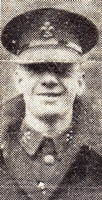
Photograph of Syd in Tameside Local Studies and Archives Centre. Reference: MR3/17/223

(L to R) 1939-45 Star; Pacific Star; 1939-45 Defence Medal; 1939-45 War Medal
Sydney, or Syd as he was known, was born on the 26th July 1914 in Ashton-under-Lyne, Lancashire. His mother was called Marjorie and he had an older brother called William, but we don't know anything else about his early life or childhood.
Syd joined the 9th Battalion of the Manchester Regiment. This was a unit of the Territorial Army (TA) based in Ashton. He was given the service number 3525858, which suggests he enlisted in around mid to late 1932.
As a TA soldier Syd kept his civilian home and job, and trained during evenings and weekends. There would also be an annual training camp, lasting around 2 weeks.
After several years in the TA, Syd decided to become a Regular soldier. On the 1st April 1938 he left his job as a general labourer and his home at 30 John Street in Ashton to join the Manchester Regiment. He was 5 feet 8 inches tall and weighed 119 pounds when he enlisted.
We don't know much about Syd's career before the outbreak of war. The 1st Battalion of the Manchester Regiment was on active service in Palestine until mid September 1938. Syd did not serve there. They then moved to Singapore.
One of Syd's closest friends was Private 3856022 Norman Atherton. He remembered that Syd 'came out in the first batch in 1940' and joined the 1st Battalion. Syd and Norman were both members of Number 4 Platoon in A Company.
We know Syd was a member of the 1st Battalion by the 1st August 1940, because he signed his will that day. He left everything to Marjorie. He held the rank of Lance Corporal at the time, but later reverted to Private.
In Singapore the battalion built defences and trained to resist an invasion. Their main role was to man pillboxes on the beaches of the island.
The Japanese invaded Malaya on the 8th December 1941. The British defended bravely, but they could not stop the Japanese advance. Syd sent a telegram home on the 25th January 1942, telling Marjorie: 'All well and safe. Please don't worry. All my love'.
By the end of January the British had been forced back onto the island of Singapore. The island was constantly bombed, and as the Japanese closed in their position became hopeless. The British garrison surrendered on the 15th February and Syd became a Prisoner of War (POW).
The confusion of the fall of Singapore meant that it took time for the British to confirm who had been captured and who was dead. Syd was reported as missing. In May 1943 Marjorie had still not heard any news of him, and wrote to the Red Cross asking for information. By July she had heard that he was safe.
At first British POWs were held in Changi prison, but soon the Japanese began to move groups to work on construction projects. Syd left Singapore in November 1942. Norman and Syd were separated when this happened. They 'vowed to keep in touch'.
Before Syd left Changi he was able to send a postcard home. It read:
Dear Mother,
I am a prisoner or war. And in good health. No wounds. Please inform all friends. Don't worry.
Love, Syd
We don't know when Marjorie received this.
From March 1943 until November 1944 Syd was held in Chungkai Camp in Thailand. Conditions in Changi had been poor, with little food or medical supplies, but in Thailand they were far worse. Sanitation, food and shelter were in short supply, and the POWs were expected to work long hours in tropical conditions. Disease was rampant, and if a soldier fell sick the Japanese would no longer feed him, on the grounds that he could not work.
Chungkai was a camp for prisoners working on the Burma Railway. Their main job was to build an embankment through bamboo thickets for the railway to run along. Chungkai was considered by the prisoners to be 'the best camp in Thailand' as far as the conditions were concerned.
Over time sick POWs from other camps were sent to the hospital there, and this soon became the camps' main function.
Syd did his best to help his ill comrades. He gave blood at least twice, on the 28th May and the 21st September 1943. The poor conditions and lack of food made this a risk to Syd's own health.
Towards the end of 1943 Syd fell ill. He was treated in the camp hospital, then after he had recovered he worked there as an orderly. In May 1944 one of the doctors wrote this testimonial:
Syd 'was a patient in the Contaminous diseases ward + subsequently for six months acted as an orderly in the ward, being a paid orderly for three months. He carried out his duties as orderly + dresser in a conscientious manner. I can recommend him for any suitable work.
9/5/44
Chun Kai Hospital
No. 2 POW Camp
In April 1944 Marjorie sent a postcard to Syd. We can't be sure when he received it. It read:
Dear Syd,Hope you are well and cheerful. All well at home. Flo writing. Always thinking of you prays for your safe return.
Love, Mother
Flo was Florence Martin.
In November 1944 Syd was moved to a camp he named as 'Wun Yie'. He was held here for the rest of the war. Japan surrendered in August 1945.
Allied forces soon reached the prisoners and began to move them out of the camps. By September Syd was in Rangoon, the capital of Burma. On the 10th he sent a telegram to Flo telling her he was 'safe in British hands' and that he was 'writing'. She lived at 228 Oldham Road in Ashton.
Syd arrived in the UK on the 7th October. When he landed he sent a telegram to his mother:
Arrived Southampton expect home shortly = Syd
Almost all POWs needed medical treatment for diseases and malnutrition. Syd officially left the Army on the 12th April 1946.
Syd lived in Ashton for the rest of his life. He married Flo between October and December 1952. We don't believe they had any children. In the late 1980s he lived at 125 Elgin Road.
Depite their vow, Syd and Norman lost touch after the war. By the mid 1970s Norman lived in Adlington near Chorley in Lancashire. He had given up 'all hope of ever seeing his old pal again. Then, out of the blue, came Syd's letter to the Guardian with the plea: "Help me trace an old Army pal. His name was Norman Atherton"'.
Norman and Syd arranged a meeting around a month later. The event was covered in the Guardian newspaper. Syd kept cuttings of the articles, but unfortunately he didn't write down the date the meeting occurred. It was 34 years after they had last seen each other, making it the winter of 1976 and 1977.
As the Guardian put it: 'They met in the snow on an Adlington street on a bitterly cold day...Syd, now a security guard with a supermarket chain, travelled by train from his home in Ashton-under-Lyne to Norman's home... on Saturday.
'And, because of frozen points on the main line...he had to delay his return journey until the following day.
'"It was a memorable weekend" said Norman. "He caught an earlier train than I expected and I saw him walking on the opposite side of the road carrying flowers when I was on my way to meet him.
"It was an emotional moment when we met. The wife cooked a marvellous lunch and we spent the whole afternoon looking back on the old times. Then we went out for a few drinks together.
"When we heard about train delays we put Syd up for the night and he didn't leave for home until the following afternoon.
"We're due to meet again in five weeks when I'll be taking my wife Patricia to his home in Ashton-under-Lyne. Syd knows a few more ex-Manchester Regiment POWs and we are all meeting up"'.
In fact Syd was a member of the Ashton Branch of the Manchester Regiment Old Comrades Association (OCA). Later, he took part in an OCA visit to the 1st Battalion of the King's Regiment in Berlin during August 1989, and another during July 1992. This was a shorter journey; the battalion was now in Hounslow, west London. The Manchester Regiment had been amalgamated to form the King's Regiment in 1958.
Syd died in Ashton in November 2006. He was 92 years old. He had donated his medals to the Museum of the Manchester Regiment in November 1987.




